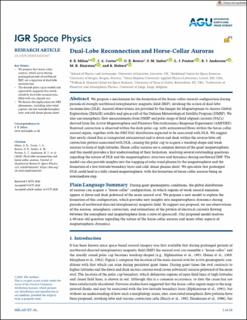| dc.contributor.author | Milan, Stephen Eric | |
| dc.contributor.author | Carter, Jennifer Alyson | |
| dc.contributor.author | Bower, G.E. | |
| dc.contributor.author | Imber, S.M. | |
| dc.contributor.author | Paxton, Larry J. | |
| dc.contributor.author | Anderson, Brian J. | |
| dc.contributor.author | Hairston, Marc | |
| dc.contributor.author | Hubert, Benoit | |
| dc.date.accessioned | 2021-08-09T08:49:33Z | |
| dc.date.available | 2021-08-09T08:49:33Z | |
| dc.date.created | 2021-03-22T12:02:32Z | |
| dc.date.issued | 2020 | |
| dc.identifier.issn | 2169-9380 | |
| dc.identifier.uri | https://hdl.handle.net/11250/2766920 | |
| dc.description.abstract | We propose a mechanism for the formation of the horse-collar auroral configuration during periods of strongly northward interplanetary magnetic field (IMF), invoking the action of dual-lobe reconnection (DLR). Auroral observations are provided by the Imager for Magnetopause-to-Aurora Global Exploration (IMAGE) satellite and spacecraft of the Defense Meteorological Satellite Program (DMSP). We also use ionospheric flow measurements from DMSP and polar maps of field-aligned currents (FACs) derived from the Active Magnetosphere and Planetary Electrodynamics Response Experiment (AMPERE). Sunward convection is observed within the dark polar cap, with antisunward flows within the horse-collar auroral region, together with the NBZ FAC distribution expected to be associated with DLR. We suggest that newly closed flux is transported antisunward and to dawn and dusk within the reverse lobe cell convection pattern associated with DLR, causing the polar cap to acquire a teardrop shape and weak auroras to form at high latitudes. Horse-collar auroras are a common feature of the quiet magnetosphere, and this model provides a first understanding of their formation, resolving several outstanding questions regarding the nature of DLR and the magnetospheric structure and dynamics during northward IMF. The model can also provide insights into the trapping of solar wind plasma by the magnetosphere and the formation of a low-latitude boundary layer and cold, dense plasma sheet. We speculate that prolonged DLR could lead to a fully closed magnetosphere, with the formation of horse-collar auroras being an intermediate step. | en_US |
| dc.language.iso | eng | en_US |
| dc.publisher | Wiley | en_US |
| dc.rights | Navngivelse 4.0 Internasjonal | * |
| dc.rights.uri | http://creativecommons.org/licenses/by/4.0/deed.no | * |
| dc.title | Dual-Lobe Reconnection and Horse-Collar Auroras | en_US |
| dc.type | Journal article | en_US |
| dc.type | Peer reviewed | en_US |
| dc.description.version | publishedVersion | en_US |
| dc.rights.holder | Copyright 2020. The Authors | en_US |
| dc.source.articlenumber | e2020JA028567 | en_US |
| cristin.ispublished | true | |
| cristin.fulltext | original | |
| cristin.qualitycode | 2 | |
| dc.identifier.doi | 10.1029/2020JA028567 | |
| dc.identifier.cristin | 1899869 | |
| dc.source.journal | Journal of Geophysical Research (JGR): Space Physics | en_US |
| dc.identifier.citation | Journal of Geophysical Research: Space Physics. 2020, 125 (10), e2020JA028567. | en_US |
| dc.source.volume | 125 | en_US |
| dc.source.issue | 10 | en_US |

